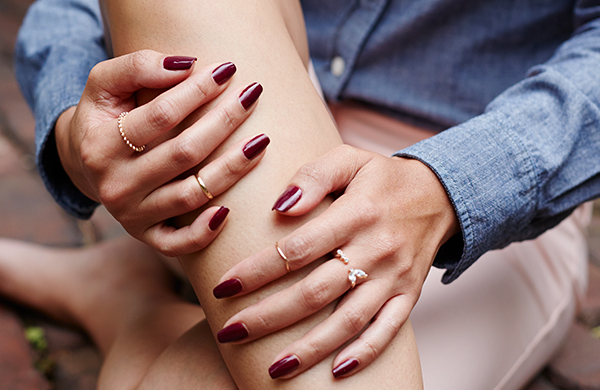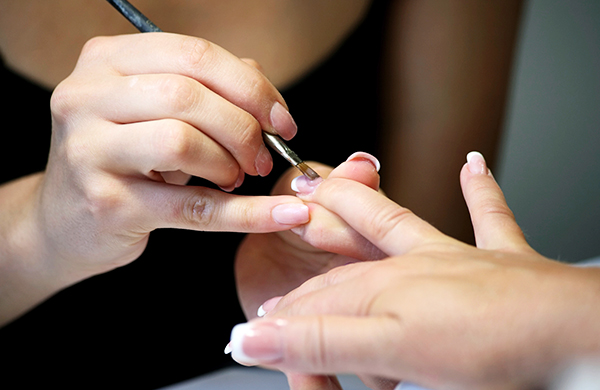
Ever since the 1950s, when a dentist dabbed acrylic on a broken fingernail in an effort to mend it, women have been sporting acrylic nails. The fake nails’ popularity has experienced peaks and valleys over the years, as certain lengths and styles have gone in and out of fashion. Some people, though, will always see them as glamorous, while others will always see them as tacky. Nowadays, they’re back in the spotlight, earning favor from celebrities such as Kylie Jenner and Rihanna.
Before you head to the nail salon to try to replicate their trendy almond, stiletto, or long, tapered-square shapes, check out our guide to all things acrylic.
What are acrylic nails?
Acrylic nails are a type of artificial nail created from two acrylic products: a liquid monomer and powdered polymer. Nail technicians mix the liquid and powder together, then apply the mixture to the natural nail, where it forms into a hard layer.
The long fake nails most people associate with acrylics are not part of every acrylic manicure. However, If clients do want nails longer than their natural shape, technicians have two ways to add length. In the first, they apply the acrylic mixture over a tip, which is basically a piece of plastic glued to the end of the natural nail. In the other, they apply the mixture atop a form, a sticker that sits under the natural nail to help the tech shape the extension. It’s removed when the acrylic mixture hardens.

What are the advantages and disadvantages of acrylics?
- Advantages: They are the strongest, most durable variety of artificial nails. They can be easily removed at home with acetone, they’re offered at almost every salon, and they tend to be cheaper than gel nails.
- Disadvantages: They can cause allergic reactions in some people, and they can get infected if bacteria finds its way into the space between the natural and artificial nail. They tend to be pretty inflexible and can rip away from the natural nail if they hit something hard. Potentially harmful fumes and flying bits of nail can make their way into the client’s or nail technician’s respiratory system.
What happens at the salon?

The application process
- Step 1: The tech files, shapes, and cleans the natural nail and pushes down cuticles.
- Step 2: The tech attaches the nail extension with glue, cuts it to the desired length, and applies the acrylic mixture over everything, using thin coats of the formula to bond the natural and fake nail together. This is the common way to create length.
- Step 3: The tech buffs the acrylic nail, files it into the final shape, then buffs some more, often using electric files and buffers.
- Step 4: The tech applies nail polish and a top coat.
The nail polish
Using traditional polish, which lasts longer on false nails than it does on natural nails, nail artists create everything from deep burgundy manicures to modernized french tips. They can also create acrylic gel nails, painting durable gel polish over the fresh acrylic coat. They should skip the buffing step of the acrylic process because gel adheres better to a rough surface.
The fills
When the natural nail starts to grow out, creeping farther and farther away from the cuticle, it’s time for a fill. This generally happens 2–3 weeks after the initial manicure. During the fill, technicians take off the polish with either a filing drill or non-acetone remover, buff the fake and natural nail, then apply the liquid acrylic mixture over everything once again before changing the polish. A fill is cheaper than a full set of new acrylics.
The removal process
Manicurists will have clients soak the fake nails in acetone for about 10–15 minutes to completely remove them.
How do you care for acrylic nails?

It’s key to keep your nails clean to prevent infections. That means frequent hand washing and scrubbing under long tips with a nail brush. Nail technicians at Nails Boutique in Chicago recommend wearing gloves while gardening and handling household chemicals. And Cheryl Menzel, the owner of Gel Nails by Cheryl in Dallas, warns people with acrylics not to use them as tools to “pick, scrape, or pry.” Both she and the Nails Boutique technicians recommend applying cuticle oil regularly to prevent peeling and lifting due to dryness.
Read more advice from professionals in our 10 Questions You Wish You Could Ask Your Nail Artist article.





